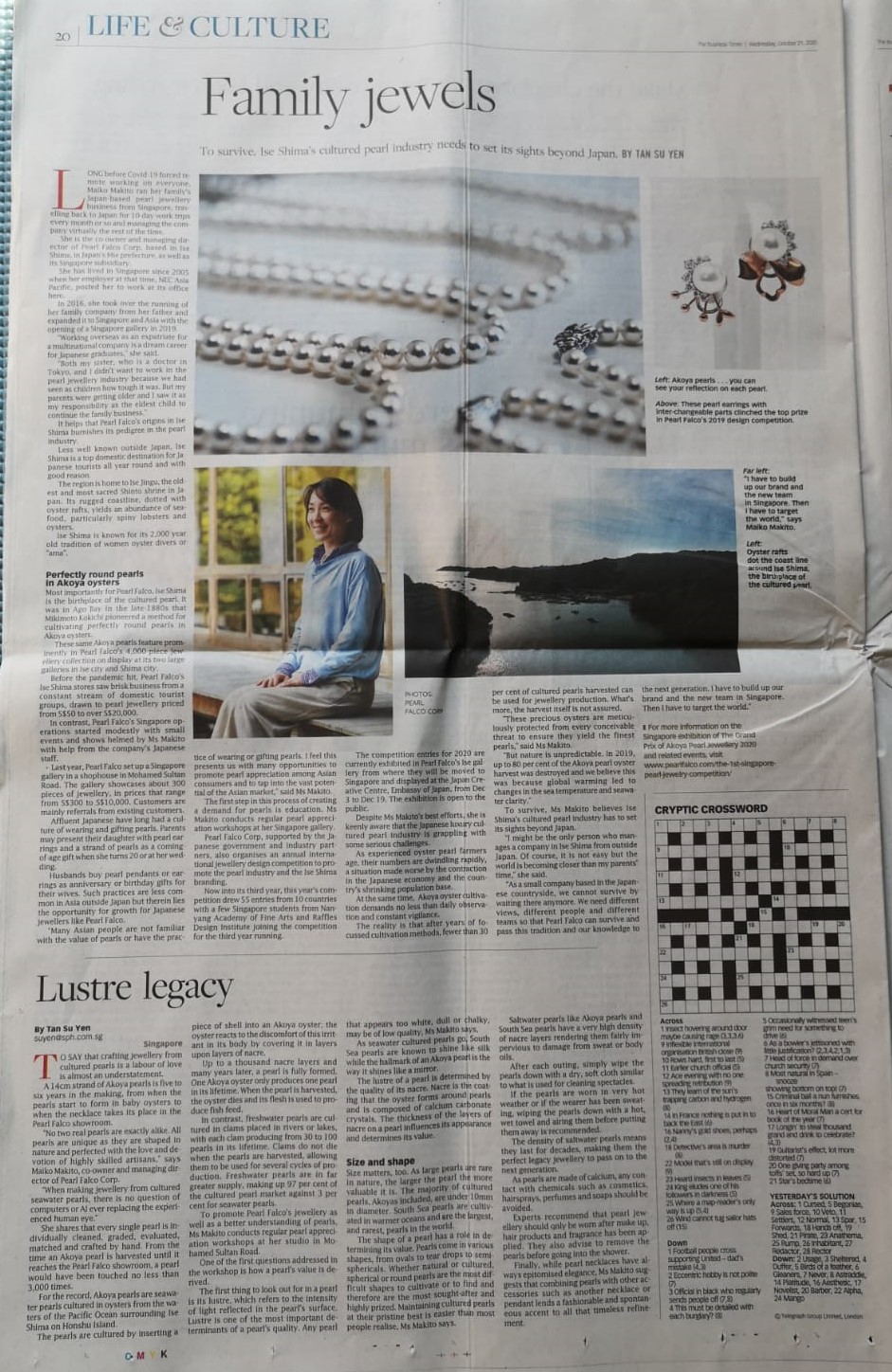
We are greatly honored that The Business Times wrote about us.
Please click on the links below or attached article to learn more
Family Jewels
https://www.businesstimes.com.sg/life-culture/family-jewels
Lustre Legacy
https://www.businesstimes.com.sg/life-culture/lustre-legacy
Family Jewels
In order to carry on the tradition of Japanese Akoya Pearls in the years to come, Ise Shima’s cultured pearl industry needs to set its sights beyond Japan.
Long before Covid-19 forced remote working on all of us, Maiko Makito ran her family’s Japan-based luxury pearl jewellery business from Singapore, travelling back to Japan for 10-day work trips once a month and managing the company virtually the rest of the time.
Maiko is the co-owner and managing director of Pearl Falco Corp, based in Ise Shima, in Japan’s Mie prefecture, as well as its Singapore subsidiary.
Maiko has lived in Singapore since 2005 when her employer at the time, NEC Asia Pacific, sent her to work at its office here.
In 2016, she took over the running of her family’s company from her parents, and expanded to Singapore and Asia with the opening of a Pearl Falco Singapore Gallery in 2019.
“Working overseas as an expatriate for a multinational company is a dream career for Japanese graduates,” she said.
“Both my sister, who is a doctor in Tokyo, and I didn’t want to work in the pearl jewellery industry because we had seen as children how tough it was.
Perfectly Round Pearls from Akoya Oysters
Not as well known outside Japan, Ise Shima is one of the top travel destinations for Japanese tourists all year round and with good reason. The region is home to Ise Jingu, the oldest and most sacred Shinto Shrine in Japan. Its rugged coastline, dotted with oyster rafts, yields an abundance of seafood, particularly spiny lobsters and oysters. Ise Shima is also known for its 2,000 year old tradition of women oyster divers or “ama.”
Most importantly for Pearl Falco, Ise Shima is the birthplace of the cultured pearl. It was in Ago Bay in the late-1880s that Mikimoto Kokichi pioneered a method for cultivating perfectly round pearls from Akoya oysters. These same Akoya pearls feature prominently in Pearl Falco’s 4,000-item jewellery collection on display at its two large galleries in both Ise and Shima City, Japan.
Before the pandemic hit, Pearl Falco’s Ise Shima stores saw brisk business from a constant stream of domestic tourist groups, drawn to pearl jewellery priced from S$50 to over S$20,000.
In contrast, Pearl Falco’s Singapore operations started modestly with small events and shows led by Ms Makito with help from the company’s Japanese staff. In 2019, Pearl Falco set up a Singapore Gallery at 33 Mohamed Sultan Road. The Singapore Gallery showcases about 300 items of jewellery, in prices that range from S$300 to S$10,000. Many of our customers are referrals from existing customers.
The Japanese have long had a culture of wearing and gifting pearls. Parents may present their daughter with pearl earrings and a strand of pearls as a coming-of-age gift when she turns 20 or at her wedding. Husbands buy pearl pendants or earrings as anniversary or birthday gifts for their wives. Such practices are less common in Asia outside Japan, but therein lies the opportunity for growth for Japanese jewellers like Pearl Falco.
“Many Asian people are not familiar with the value of pearls or have the practice of wearing or gifting pearls. I feel this presents us with many opportunities to promote pearl appreciation among Asian consumers and to tap into the vast potential of the Asian market,” said Ms Makito.
The first step in this process of creating a demand for pearls is education. Ms Makito conducts regular pearl appreciation workshops at her Singapore Gallery.
Pearl Falco Corp, supported by the Japanese government and industry partners, also organises an annual international jewellery design competition to promote Ise Shima’s pearl industry. Now in its 3rd year, this year’s competition drew 55 entries from 10 countries with Singapore students from Nanyang Academy of Fine Arts and Raffles Design Institute joining the competition for the third year running.
The competition entries for 2020 are currently exhibited in Pearl Falco’s Ise gallery from where they will be moved to Singapore and displayed at the Japan Creative Centre, Embassy of Japan, from Dec 3 to Dec 19. The exhibition is open to the public.
Despite Ms Makito’s best efforts, Maiko is keenly aware that the Japanese luxury cultured pearl industry is grappling with some serious challenges.
As experienced oyster pearl farmers age, their numbers are dwindling rapidly, a situation made worse by the contraction in the Japanese economy and the country’s shrinking population base. At the same time, Akoya oyster cultivation demands no less than daily observation and constant vigilance.
The reality is that after years of focused cultivation methods, fewer than 30% of cultured pearls harvested can be used for jewellery production. What’s more, the harvest itself is not fully assured.
“These precious oysters are meticulously protected from every conceivable threat to ensure they yield the finest pearls,” said Ms Makito.
“But nature is unpredictable. In 2019, up to 80 per cent of the Akoya pearl oyster harvest was destroyed and we believe this was largely due to global warming, which led to changes in the sea temperature and seawater clarity.”
In order for Ise Shima’s cultured pearl industry to thrive in the years to come, Ms Makito now sets her sights beyond Japan.
Maiko commented, “I might currently be the only person who manages a company in Ise Shima here in Singapore. Of course, it is not easy but the world is becoming smaller than in my parents’ time.”
“As a small company based in the Japanese countryside, we cannot survive by waiting there anymore. We need different views, different people and different teams so that Pearl Falco can survive and pass this tradition and our knowledge to the next generation. I have to build up our brand and the new team in Singapore. Then I have to target the world.”
- For More Information on the Singapore Exhibition of The Grand Prix of Akoya Pearl Jewellery 2020 and Related Events, Please Visit www.pearlfalco.com/the-1st-singapore-pearl-jewelry-competition/
Lustre Legacy
To say that crafting jewellery from cultured pearls is a labour of love is an understatement.
A 40cm strand of Akoya pearls takes five to six years to create – from the day the pearls start to form in baby oysters until the necklace takes its place in the Pearl Falco showroom.
“No two real pearls are exactly alike. All pearls are unique as they are shaped in nature and perfected with the love and devotion of highly skilled artisans,” says Maiko Makito, co-owner and managing director of Pearl Falco Corp.
“When making Jewellery from cultured seawater pearls, there is no question of computers or AI ever replacing the experienced human eye.”
Maiko shares how every single pearl is individually cleaned, graded, evaluated, matched and crafted by hand. From the time an Akoya pearl is harvested until it reaches the Pearl Falco showroom, a pearl will have been touched no less than 3,000 times. For the record, Akoya pearls are saltwater pearls cultured in oysters from the waters of the Pacific Ocean surrounding Ise Shima on Honshu Island.
The pearls are cultured by inserting a piece of shell into an Akoya oyster; the oyster reacts to the discomfort by covering the shell fragment in layer upon layer of nacre.
Up to 1,000 nacre layers and 5 to 6 years later, a cultured pearl is fully formed. An Akoya oyster produces only one pearl in its lifetime. When the pearl is harvested, the oyster dies and its flesh is used to produce fish feed.
In contrast, freshwater pearls are cultured in clams placed in rivers or lakes, with each clam producing 30 to 100 pearls in its lifetime. Clams do not die when the pearls are harvested, allowing a clam to create several pearls in its lifetime. Freshwater pearls are in far greater supply, making up to 97% of the cultured pearl market vs 3% for saltwater pearls.
To promote Pearl Falco’s Jewellery as well as a better understanding of pearls, Ms Makito conducts regular pearl appreciation workshops at her Studio at 33 Mohamed Sultan Road.
One of the first questions addressed in the workshop is how a pearl’s value is determined. The first thing to look for in a cultured pearl is its lustre, which refers to the intensity of light reflected in the pearl’s surface. Lustre is one of the most important factors of a pearl’s quality. Any pearl that appears too white, dull or chalky may be of low quality, Ms Makito says.
The luster of a pearl is determined by the quality of its nacre. Nacre is the coating the oysters form around pearls and is composed of calcium carbonate crystals. The thickness of the layers of nacre on a pearl influences its appearance and helps to determine its value.
As saltwater cultured pearls go, South Sea or Tahitian pearls are known to shine like silk, while Akoya pearls are known to shine more reflectively, more like mirrors.
Size and Shape
I
Size matters too. As large pearls are rare in nature, the larger the pearl the more valuable it is. The majority of cultured pearls, Akoya included, are under 10mm in diameter. South Sea pearls are cultivated in warmer oceans and are the largest and rarest pearls in the world.
The shape of a pearl plays a role in determining its value. Pearls come in various shapes, from ovals to tear drops to semi spherical. Whether natural or cultured, spherical or round pearls are the most difficult shapes to cultivate and therefore are the most sought-after and highly prized. Maintaining cultured pearls at their pristine best is easier than most people realize, Ms Makito says.
Saltwater pearls like Akoya pearls and South Sea pearls have a high density of nacre layers rendering them fairly impervious to damage from perspiration or body oils.
After each outing, simply wipe the pearls down with a dry soft cloth similar to what is used for cleaning spectacles.
If the pearls are worn in very hot weather or if the wearer has been perspiring, wiping pearls down with a hot, wet towel and airing them before putting them away is recommended.
The density of saltwater pearls ensures they will last for decades, making them the perfect legacy jewellery to pass on to the next generation.
As pearls are made of calcium, any contact with man made chemicals such as cosmetics, hairsprays, perfumes and soaps should be avoided.
It is recommended that pearl jewellery should only be worn after make-up, hair products and fragrances have been applied. Pearls should also be removed before showering.
Finally, while pearl necklaces have always epitomized elegance, Ms Makito suggests how combining pearls with other accessories such as other necklaces or pendants may lend a fashionable and spontaneous accent to the timeless refinement of cultured pearls.

